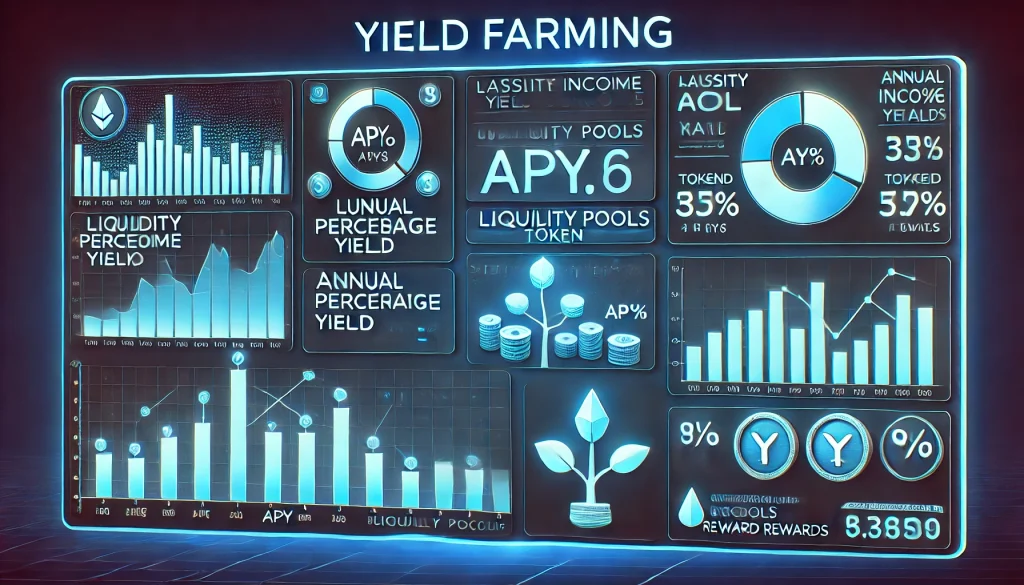
Yield farming has become one of the hottest trends in cryptocurrency, particularly in the decentralized finance (DeFi) space. This method of earning passive income through staking and lending crypto assets has attracted both seasoned investors and beginners seeking higher returns. Yield farming is essential for those looking to maximize their holdings without actively trading. With platforms offering high-interest rates, it’s an opportunity to let your crypto work for you.
Yield farming not only boosts returns but also strengthens the overall DeFi ecosystem by providing liquidity to decentralized platforms. This guide will walk you through the steps of getting started with yield farming, the tools needed, and the best practices to follow for successful yield farming in cryptocurrency.
Materials or Tools Needed
Before diving into yield farming, it’s important to gather the necessary tools and ensure you have the prerequisites ready. These include:
- A cryptocurrency wallet (such as MetaMask or Trust Wallet)
- Access to a decentralized platform (like Uniswap, Aave, or Compound)
- Funds in the form of cryptocurrency (ETH, USDC, or others)
- Familiarity with DeFi platforms and smart contracts
Yield farming involves staking or lending your crypto assets, so you’ll need a basic understanding of how DeFi platforms operate. Once you have these tools and a secure internet connection, you can move on to the next steps.
Step-by-Step Instructions

Step 1: Choose the Right Platform
Selecting a reliable and well-established platform is critical to successful yield farming. DeFi platforms like Aave, Compound, and Uniswap offer users the ability to lend or stake their assets in exchange for returns. Research the reputation, security, and supported assets of each platform before committing your funds.
- Start by reviewing different DeFi platforms.
- Compare the annual percentage yields (APY) offered.
- Choose a platform that aligns with your preferred cryptocurrency and staking options.
Ensure that you also check for platform fees and security features to avoid potential losses due to hacks or vulnerabilities.
Step 2: Connect Your Wallet to a DeFi Platform
Once you’ve selected a platform, the next step is to connect your cryptocurrency wallet. Most decentralized platforms support wallets such as MetaMask or Trust Wallet, which allow you to manage your funds and interact with DeFi applications seamlessly.
- Install a compatible wallet extension on your browser.
- Transfer your chosen cryptocurrency (e.g., ETH or USDC) into the wallet.
- Connect the wallet to the DeFi platform by following the platform’s prompts.
It’s essential to ensure that your wallet is connected correctly and securely to avoid any errors during the transaction process.
Step 3: Stake or Lend Your Assets
With your wallet connected, you are now ready to start yield farming. This process involves staking or lending your assets in exchange for interest or liquidity provider (LP) tokens.
- Choose the assets you want to stake or lend.
- Enter the amount you wish to provide and confirm the transaction.
- Monitor the returns, which are typically paid out daily or weekly.
The platform may offer multiple staking options, each with different interest rates and lock-up periods. Higher APYs often come with higher risks, so it’s important to weigh the potential returns against the risks involved.
Do’s and Don’ts of Yield Farming

Yield farming, while lucrative, comes with risks. To maximize your profits and avoid common pitfalls, keep the following tips in mind:
Do’s:
- Diversify your assets. Spread your investments across different platforms and assets to minimize risk.
- Monitor gas fees. Transactions on platforms like Ethereum can incur high fees, so always calculate whether the yield will cover your costs.
- Use trusted platforms. Stick to well-known DeFi platforms that have undergone audits and are supported by a strong community.
Don’ts:
- Don’t stake more than you can afford to lose. Cryptocurrency markets are volatile, and there’s always a risk of losing funds due to smart contract bugs or platform failures.
- Avoid jumping into new platforms without proper research. Scammers often target yield farmers with fake platforms or phishing attacks.
- Don’t ignore liquidity risks. If a platform becomes illiquid, it may be difficult to withdraw your assets in a timely manner.
By following these tips, you can mitigate some of the inherent risks and maximize your yield farming returns.
Conclusion
Yield farming in cryptocurrency is an excellent way to generate passive income, especially in the growing DeFi space. By choosing a reliable platform, connecting your wallet, and staking your assets, you can begin earning rewards in a matter of minutes. Always be cautious of potential risks, such as high fees and liquidity concerns, but when done correctly, yield farming can offer impressive returns on your crypto investments.
For those new to the world of cryptocurrency, yield farming provides an engaging way to get involved without the need for constant trading. Start small, learn the ropes, and watch your crypto portfolio grow.
FAQ
What is the risk involved in yield farming?
Yield farming carries risks such as smart contract vulnerabilities, platform liquidity issues, and the volatility of cryptocurrency prices. Always research platforms before investing.
Can I yield farm with any cryptocurrency?
Not all cryptocurrencies are eligible for yield farming. Popular coins like ETH, USDC, and DAI are often supported by major platforms, but availability depends on the specific DeFi application.
How often do I receive rewards from yield farming?
Most platforms distribute rewards on a daily or weekly basis, although the frequency may vary depending on the platform and the asset being staked.
